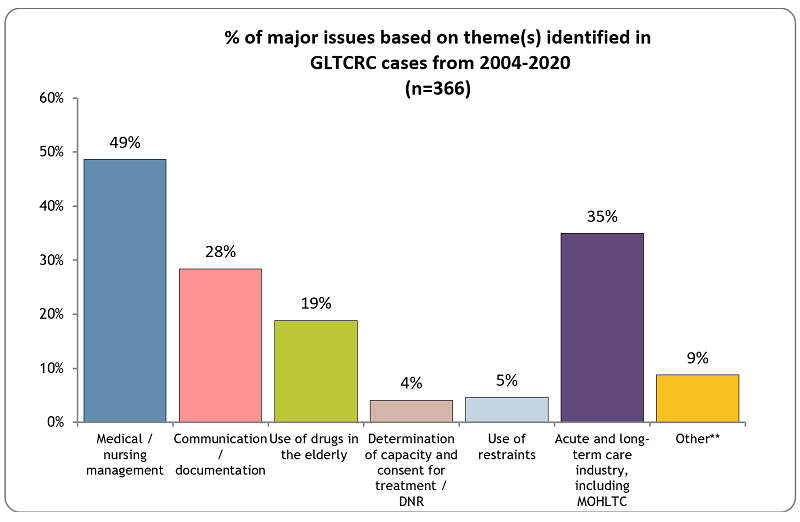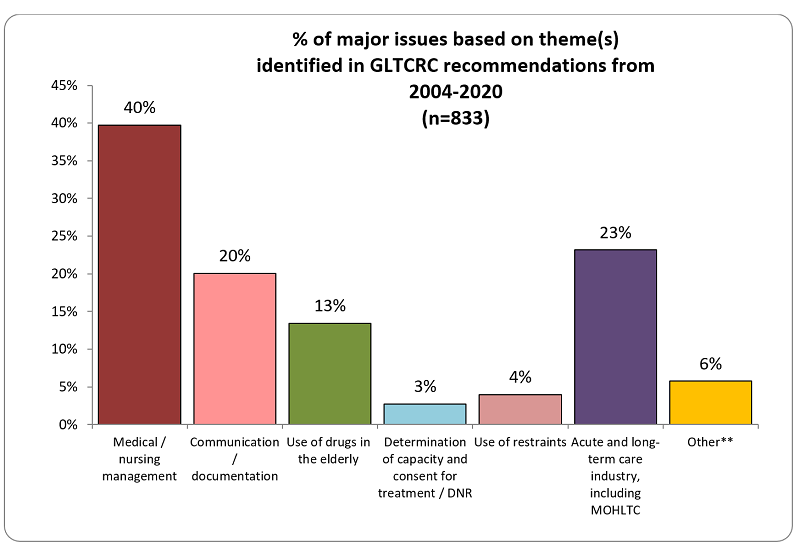Statistical overview (2004–2020)
Between 2004 and 2020, the GLTCRC reviewed a total of 366 cases and generated 833 recommendations aimed towards the prevention of future deaths. On average, the GLTCRC has reviewed 21.5 cases and generated 49 recommendations per year.
It is recognized that there is an inherent bias as to which cases undergo review (i.e. most cases are discretionary referrals sent to GLTCRC due to the presence of identified concerns and issues). There is also the possibility of researcher bias in attributing certain themes to cases and recommendations. It is also recognized however, that regardless of these potential biases, there are certain recurring themes that have emerged over the years. These themes can be applied at a broader level to cases and more specifically to focused recommendations.
The themes identified include:
- Medical and nursing management
- Communication and documentation
- Use of drugs in the elderly
- Use of restraints
- Determination of capacity and consent for treatment/DNR
- The acute care and long-term care industry in Ontario, including the Ministry of Health and Long-Term Care (MOHLTC)
- Other: includes other Ontario ministries, justice and legal systems
The following statistical analysis on themes has been broken down into two distinct sections:
- An analysis of themes based on individual cases reviewed
- An analysis of themes based on individual recommendations made
By breaking the analysis down into cases vs. recommendations, it is possible to observe general trends relating to themes that emerge throughout cases that have been referred and reviewed by the GLTCRC, compared to themes that have emerged from specific recommendations.
Trends based on themes in cases helps to identify what issues or themes are present in the cases that are being referred to the GLTCRC for review. These findings help to identify if there is a trend in the types of cases that are being referred and reviewed.
Trends based on themes in recommendations helps to identify what specific themes/issues have been identified and addressed in recommendations aimed toward the prevention of future similar deaths. A trend in themes of recommendations helps to identify specific areas where the need for change, action or attention has been suggested.
Graph One: Percent of major issues based on theme identified in GLTCRC cases from 2004–2020
From 2004 until 2020, the GLTCRC has reviewed a total of 366 cases.
Many cases had more than one theme/issue attributed to the recommendations.
Graph Two: Percent of major issues based on theme(s) identified in GLTCRC recommendations (2004–2020)
From 2004 until 2020, the GLTCRC generated 833 recommendations aimed at the prevention of future deaths.
Note: Some recommendations had more than one theme/issue attributed.
Note: 'Other' includes recommendations to other ministries or in the legal/justice sector

